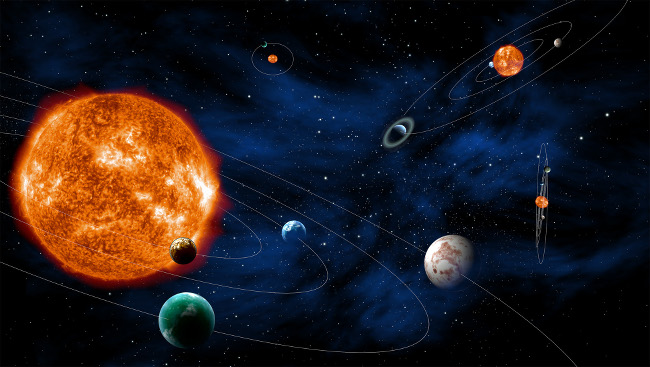
The celestial bodies revolves around the Sun, which includes 8 planets, 180 satellites, comets, meteors and asteroids, together constitute the Solar System.
Top 10 Planets with the Largest Number of Moons or Natural Satellites
The list of top 10 Planets with the largest number of moons or natural satellites are given below along with their number of satellite:
10. Eris
It is the most massive and second-largest (by volume) dwarf planet in the known Solar System. This was discovered by a Palomar Observatory-based team led by Mike Brown in January 2005.
Number of Satellites (Moons): 1
9. Makemake
It is a dwarf planet and discovered by a team led by Michael E. Brown on March 31, 2005. It is one of the bodies that caused Pluto to lose its status as a planet.
Number of Satellites (Moons): 1
8. Earth
It is the third planet from the sun and only planet known to have an atmosphere containing free oxygen, oceans of water on its surface and, of course, life.
Number of Satellites (Moons): 1
Interesting facts about Earth’s Hydrosphere
7. Haumea
It is a dwarf planet located beyond Neptune’s orbit. It was discovered by a team headed by Mike Brown of Caltech at the US Palomar Observatory and independently in 2005, by a team headed by José Luis Ortiz Moreno at the Sierra Nevada Observatory in Spain, though the latter claim has been contested.
Number of Satellites (Moons): 2
6. Mars
It is the fourth planet from the Sun and the second-smallest planet in the Solar System after Mercury. It is named after the Roman god of war, and is often referred to as the “Red Planet”.
Number of Satellites (Moons): 2
5. Pluto
It is a dwarf planet in the Kuiper belt, a ring of bodies beyond Neptune. It was discovered by Clyde Tombaugh in 1930 but after
Number of Satellites (Moons): 5
4. Neptune
It is the eighth and farthest known planet of the Solar System. It is the fourth-largest planet by diameter, the third-most-massive planet, and the densest giant planet of the Solar System.
Number of Satellites (Moons): 14
Which Planet in Our Solar System has highest Gravitational Force?
3. Uranus
It is the seventh planet from the Sun and it is larger in diameter but smaller in mass than Neptune. It has similar composition like Neptune, and both have bulk chemical compositions which differ from that of the larger gas giants Jupiter and Saturn.
Number of Satellites (Moons): 27
2. Saturn
It is the sixth planet from the Sun and the second-largest in the Solar System, after Jupiter. It is named after the Roman god of agriculture.
Number of Satellites (Moons): 62
1. Jupiter
It is the fifth planet from the Sun and named after the Roman god Jupiter.
Number of Satellites (Moons): 67
Biggest Natural Satellite in the Solar System
Planets with the Largest Number of Moons
| Name of Planet | Number Of Satellites (Moons) |
| 1. Jupiter | 67 |
| 2. Saturn | 62 |
| 3. Uranus | 27 |
| 4. Neptune | 14 |
| 5. Pluto | 5 |
| 6. Mars | 2 |
| 7. Haumea | 2 |
| 8. Earth | 1 |
| 9. Makemake | 1 |
| 10. Eris | 1 |
The average density of the universe is very low because of its infinite volume. It consists of 73% dark energy, 23% cold dark matter and 4% ordinary matter. Dark matter gravitates as ordinary matter and slows down the expansion of the Universe, whereas dark energy accelerates its expansion.

